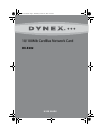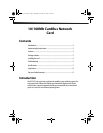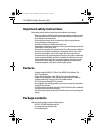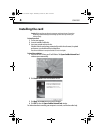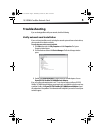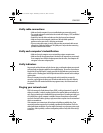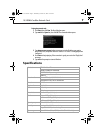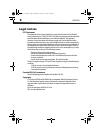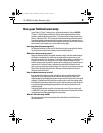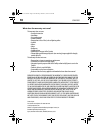
6
DX-E202
Verify cable connections
• Make sure that the computer(s) you are troubleshooting are connected correctly.
• The network card must be connected to the network with Category 5 UTP (unshielded
twisted pair) cables.
• Examine the network cables and make sure that they have not been damaged.
• Make sure that no electromagnetic interference, like unshielded speakers or
appliances on the same circuit, is affecting your network.
• If you are using a hub, router, or switch, make sure that your network cables are not
plugged into a dedicated Uplink port. The Uplink port is only used when connecting
your hub to another hub or switch.
Verify each computer’s indentification
• Make sure that each computer on your network has a unique computer name.
• Make sure that all the workgroup name is identical for all computers on your network.
If one computer has a different workgroup name than the others, that computer will
not appear in the same workgroup view.
Verify indicators
Your network card has indicators or lights that can give you information about your network
traffic and help you determine problems when troubleshooting. The card has two indicators
labeled Link/Act and Full Duplex. A steady green Link/Act light indicates a good connection
with the switch. A flashing green Link/Act light indicates that the network card is sending or
receiving data.
When your computer is turned on and the network card is inserted into an open slot
connector, a green light on the direct port LED indicator indicates that the card is linked to
the network.If the LED remains dark without any apparent cause, check the network card
installation.
Pinging your network card
PING is the acronym for Packet Internet Groper (PING), a utility to determine if a specific IP
address is accessible. It works by sending a packet to the specified address and waiting for a
reply. Ping is primarily used to troubleshoot Internet connections. By sending out a ping, you
are verifying that a specific computer is available. Because all computers on the network
must have a unique IP address, getting a reply means that a computer is on the network and
that it can communicate.
If the computers can communicate, the hardware and cabling are probably okay. If you
cannot ping another computer, there is probably a problem with the hardware. Check the
cabling and adapter installation. If you are unable to network, even when you receive a reply
to your ping, there is probably a software configuration problem. Verify that all the settings
are correct.
Dynex-A5-ENG.fm Page 6 Wednesday, October 21, 2009 10:04 AM



